Overview
- Brief Narrative
- Artistic rendering of Camp Bergen-Belsen documenting the liberation period. The artist Erwin Abadi was an Hungarian victim of the Holocaust interned in the concentration camp Bergen-Belsen. He remained hospitalized in Belsen after liberation where he created dozens of works of art.
- Date
-
creation:
1945
- Geography
-
creation:
DP-Camp Bergen-Belsen;
Belsen (Bergen, Celle, Germany)
- Credit Line
- United States Holocaust Memorial Museum Collection, Gift of Eva and George Bozoki, In memory of their parents, Magda and Janos Gombosi and Erzsebet and Gyula Braun
- Contributor
-
Artist:
Ervin Abadi
- Biography
-
Ervin (Aaron) Abadi was born on April 9, 1918. When the war broke out with the invasion of Poland by Germany in September 1939, Ervin was living in Budapest, Hungary, pursuing a career as a painter. Beginning in 1939/40, all Jewish males were subject to foced labor service. Hungary, a German ally, joined in the invasion of the Soviet Union launched in June 1941. Forced labor battalions were under the command of the Hungarian Army and Ervin's battalion was taken to the Soviet Union. He escaped but was captured in the Karpet Mountains. He was brutally mistreated upon his return and escaped again, but was recaptured and sent to Bergen Belsen concentration camp in Germany. In early April 1945, as Allied troops reached the area, the Germans began to evacuate some prisoners. Abadi was placed on a train with about 2000 other inmates, many very ill, as well as a large number of children. The bombing of rail lines throughout the area impeded travel and the train could not get to its intended destination, likely Theresienstadt in Czechoslovakia. After seven days, the German guards fled and abandoned the train near Farsleben and Madgeburg, Germany. On April 13, the train was discovered by American troops of the 30th Infantry Division. Abadi was extremely ill with typhus and was hospitalized at Hillersleben. While in the camp and after, Abadi made a number of ink drawings watercolors detaling his labor battalion and concentration camp experiences. He eventually returned to Budapest where he gave illustrated talks about his life as a forced laborer and an inmate of Bergen Belsen. The work was published in an edition of 500 with Hungarian and English captions in 1946. The foreword of the book says, in part, "Let these drawings serve as proof of my everlasting gratitude towards those to whom I owe my life. ... To the soldiers of the United States Army, particularly to our immediate liberators, those soldiers of the 9th regiment who first entered the village of Zilitz and gave us bread, milk, chocolate, and cigarettes...." Abadi became disillusioned by Communist Hungary and managed to leave for Israel in 1947 or 1948. He changed his name to Aharon (Aaron.) He wrote 15 books in both Hebrew and Hungarian. Aharon died in 1979 in Tel Aviv, Israel.
Physical Details
- Classification
-
Art
- Category
-
Drawings
- Object Type
-
Drawing (lcsh)
- Dimensions
- overall: Height: 4.490 inches (11.405 cm) | Width: 3.070 inches (7.798 cm) | Depth: 7.800 inches (19.812 cm)
- Materials
- overall : paper, ink, adhesive
Rights & Restrictions
- Conditions on Access
- No restrictions on access
- Conditions on Use
- No restrictions on use
Administrative Notes
- Legal Status
- Permanent Collection
- Provenance
- The drawing was donated to the United States Holocaust Memorial Museum in 1992 by George and Eva Bozoki, friends of Ervin Abadi.
- Funding Note
- The cataloging of this artifact has been supported by a grant from the Conference on Jewish Material Claims Against Germany.
- Record last modified:
- 2023-06-21 16:25:51
- This page:
- https://collections.ushmm.org/search/catalog/irn6138
Download & Licensing
In-Person Research
- By Appointment
- Request 21 Days in Advance of Visit
- Plan a Research Visit
- Request to See This Object
Contact Us
Also in Ervin Abadi collection
The collection consists of eighty-six artworks created by Ervin Abadi while hospitalized after his liberation from Bergen-Belsen concentration camp in April 1945.
Date: 1945
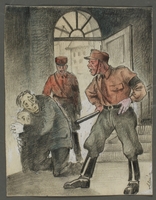
Drawing by Ervin Abadi created while at Bergen Belsen displaced person's camp
Object
Artistic rendering of Camp Bergen-Belsen documenting the liberation period. The artist Erwin Abadi was an Hungarian victim of the Holocaust interned in the concentration camp Bergen-Belsen. He was hospitalized after liberation where he created dozens of works of art.
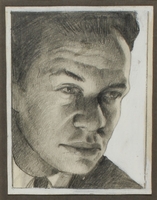
Drawing by Ervin Abadi created while at Bergen Belsen displaced person's camp
Object
Artistic rendering of Camp Bergen-Belsen documenting the liberation period. The artist Erwin Abadi was an Hungarian victim of the Holocaust interned in the concentration camp Bergen-Belsen. He remained hospitalized in Belsen after liberation where he created dozens of works of art.
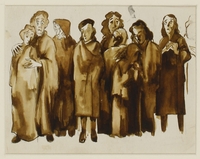
Drawing by Ervin Abadi created while at Bergen Belsen displaced person's camp
Object
Artistic rendering of Camp Bergen-Belsen documenting the liberation period. The artist Erwin Abadi was an Hungarian victim of the Holocaust interned in the concentration camp Bergen-Belsen. He remained hospitalized in Belsen after liberation where he created dozens of works of art.
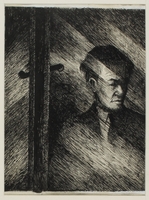
Drawing by Ervin Abadi created while at Bergen Belsen displaced person's camp
Object
Artistic rendering of Camp Bergen-Belsen documenting the liberation period. The artist Erwin Abadi was an Hungarian victim of the Holocaust interned in the concentration camp Bergen-Belsen. He remained hospitalized in Belsen after liberation where he created dozens of works of art.
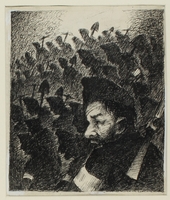
Drawing by Ervin Abadi created while at Bergen Belsen displaced person's camp
Object
Artistic rendering of Camp Bergen-Belsen documenting the liberation period. The artist Erwin Abadi was an Hungarian victim of the Holocaust interned in the concentration camp Bergen-Belsen. He remained hospitalized in Belsen after liberation where he created dozens of works of art.
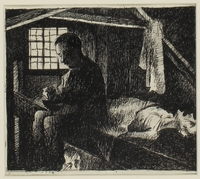
Drawing by Ervin Abadi created while at Bergen Belsen displaced person's camp
Object
Artistic rendering of Camp Bergen-Belsen documenting the liberation period. The artist Erwin Abadi was an Hungarian victim of the Holocaust interned in the concentration camp Bergen-Belsen. He remained hospitalized in Belsen after liberation where he created dozens of works of art.
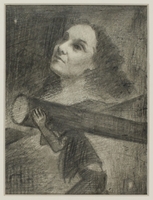
Drawing by Ervin Abadi created while at Bergen Belsen displaced person's camp
Object
Artistic rendering of Camp Bergen-Belsen documenting the liberation period. The artist Erwin Abadi was an Hungarian victim of the Holocaust interned in the concentration camp Bergen-Belsen. He remained hospitalized in Belsen after liberation where he created dozens of works of art.
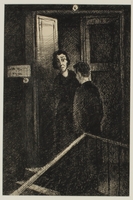
Drawing by Ervin Abadi created while at Bergen Belsen displaced person's camp
Object
Artistic rendering of Camp Bergen-Belsen documenting the liberation period. The artist Erwin Abadi was an Hungarian victim of the Holocaust interned in the concentration camp Bergen-Belsen. He remained hospitalized in Belsen after liberation where he created dozens of works of art.
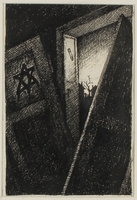
Drawing by Ervin Abadi created while at Bergen Belsen displaced person's camp
Object
Artistic rendering of Camp Bergen-Belsen documenting the liberation period. The artist Erwin Abadi was an Hungarian victim of the Holocaust interned in the concentration camp Bergen-Belsen. He remained hospitalized in Belsen after liberation where he created dozens of works of art.
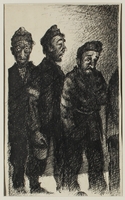
Drawing by Ervin Abadi created while at Bergen Belsen displaced person's camp
Object
Artistic rendering of Camp Bergen-Belsen documenting the liberation period. The artist Erwin Abadi was an Hungarian victim of the Holocaust interned in the concentration camp Bergen-Belsen. He remained hospitalized in Belsen after liberation where he created dozens of works of art.
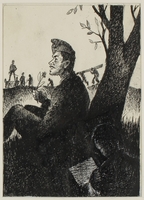
Drawing by Ervin Abadi created while at Bergen Belsen displaced person's camp
Object
Artistic rendering of Camp Bergen-Belsen documenting the liberation period. The artist Erwin Abadi was an Hungarian victim of the Holocaust interned in the concentration camp Bergen-Belsen. He remained hospitalized in Belsen after liberation where he created dozens of works of art.
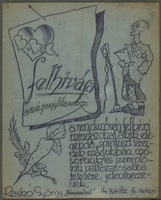
Drawing by Ervin Abadi created while at Bergen Belsen displaced person's camp
Object
Artistic rendering of Camp Bergen-Belsen documenting the liberation period. The artist Erwin Abadi was an Hungarian victim of the Holocaust interned in the concentration camp Bergen-Belsen. He remained hospitalized in Belsen after liberation where he created dozens of works of art.
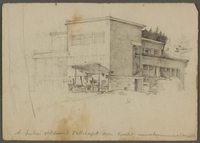
Drawing by Ervin Abadi created while at Bergen Belsen displaced person's camp
Object
Artistic rendering of Camp Bergen-Belsen documenting the liberation period. The artist Erwin Abadi was an Hungarian victim of the Holocaust interned in the concentration camp Bergen-Belsen. He remained hospitalized in Belsen after liberation where he created dozens of works of art.
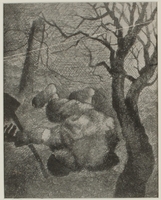
Drawing by Ervin Abadi created while at Bergen Belsen displaced person's camp
Object
Artistic rendering of Camp Bergen-Belsen documenting the liberation period. The artist Erwin Abadi was an Hungarian victim of the Holocaust interned in the concentration camp Bergen-Belsen. He remained hospitalized in Belsen after liberation where he created dozens of works of art.
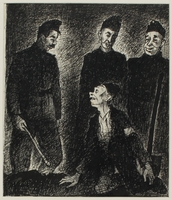
Drawing by Ervin Abadi created while at Bergen Belsen displaced person's camp
Object
Artistic rendering of Camp Bergen-Belsen documenting the liberation period. The artist Erwin Abadi was an Hungarian victim of the Holocaust interned in the concentration camp Bergen-Belsen. He remained hospitalized in Belsen after liberation where he created dozens of works of art.
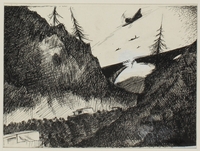
Drawing by Ervin Abadi created while at Bergen Belsen displaced person's camp
Object
Artistic rendering of Camp Bergen-Belsen documenting the liberation period. The artist Erwin Abadi was an Hungarian victim of the Holocaust interned in the concentration camp Bergen-Belsen. He remained hospitalized in Belsen after liberation where he created dozens of works of art.
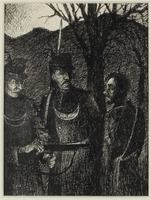
Drawing by Ervin Abadi created while at Bergen Belsen displaced person's camp
Object
Artistic rendering of Camp Bergen-Belsen documenting the liberation period. The artist Erwin Abadi was an Hungarian victim of the Holocaust interned in the concentration camp Bergen-Belsen. He remained hospitalized in Belsen after liberation where he created dozens of works of art.
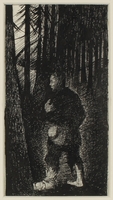
Drawing by Ervin Abadi created while at Bergen Belsen displaced person's camp
Object
Artistic rendering of Camp Bergen-Belsen documenting the liberation period. The artist Erwin Abadi was an Hungarian victim of the Holocaust interned in the concentration camp Bergen-Belsen. He remained hospitalized in Belsen after liberation where he created dozens of works of art.
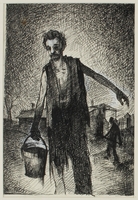
Drawing by Ervin Abadi created while at Bergen Belsen displaced person's camp
Object
Artistic rendering of Camp Bergen-Belsen documenting the liberation period. The artist Erwin Abadi was an Hungarian victim of the Holocaust interned in the concentration camp Bergen-Belsen. He remained hospitalized in Belsen after liberation where he created dozens of works of art.
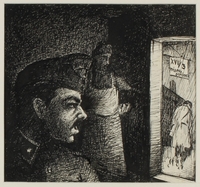
Drawing by Ervin Abadi created while at Bergen Belsen displaced person's camp
Object
Artistic rendering of Camp Bergen-Belsen documenting the liberation period. The artist Erwin Abadi was an Hungarian victim of the Holocaust interned in the concentration camp Bergen-Belsen. He remained hospitalized in Belsen after liberation where he created dozens of works of art.
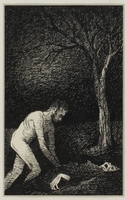
Drawing by Ervin Abadi created while at Bergen Belsen displaced person's camp
Object
Artistic rendering of Camp Bergen-Belsen documenting the liberation period. The artist Erwin Abadi was an Hungarian victim of the Holocaust interned in the concentration camp Bergen-Belsen. He remained hospitalized in Belsen after liberation where he created dozens of works of art.

Drawing by Ervin Abadi created while at Bergen Belsen displaced person's camp
Object
Artistic rendering of Camp Bergen-Belsen documenting the liberation period. The artist Erwin Abadi was an Hungarian victim of the Holocaust interned in the concentration camp Bergen-Belsen. He remained hospitalized in Belsen after liberation where he created dozens of works of art.
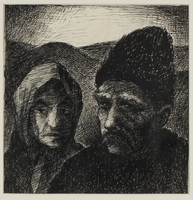
Drawing by Ervin Abadi created while at Bergen Belsen displaced person's camp
Object
Artistic rendering of Camp Bergen-Belsen documenting the liberation period. The artist Erwin Abadi was an Hungarian victim of the Holocaust interned in the concentration camp Bergen-Belsen. He remained hospitalized in Belsen after liberation where he created dozens of works of art.
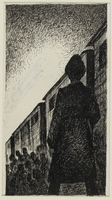
Drawing by Ervin Abadi created while at Bergen Belsen displaced person's camp
Object
Artistic rendering of Camp Bergen-Belsen documenting the liberation period. The artist Erwin Abadi was an Hungarian victim of the Holocaust interned in the concentration camp Bergen-Belsen. He remained hospitalized in Belsen after liberation where he created dozens of works of art.

Drawing by Ervin Abadi created while at Bergen Belsen displaced person's camp
Object
Artistic rendering of Camp Bergen-Belsen documenting the liberation period. The artist Erwin Abadi was an Hungarian victim of the Holocaust interned in the concentration camp Bergen-Belsen. He remained hospitalized in Belsen after liberation where he created dozens of works of art.
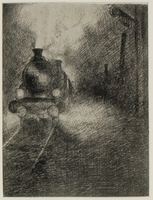
Drawing by Ervin Abadi created while at Bergen Belsen displaced person's camp
Object
Artistic rendering of Camp Bergen-Belsen documenting the liberation period. The artist Erwin Abadi was an Hungarian victim of the Holocaust interned in the concentration camp Bergen-Belsen. He remained hospitalized in Belsen after liberation where he created dozens of works of art.
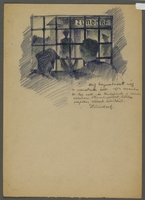
Drawing by Ervin Abadi created while at Bergen Belsen displaced person's camp
Object
Artistic rendering of Camp Bergen-Belsen documenting the liberation period. The artist Erwin Abadi was an Hungarian victim of the Holocaust interned in the concentration camp Bergen-Belsen. He remained hospitalized in Belsen after liberation where he created dozens of works of art.
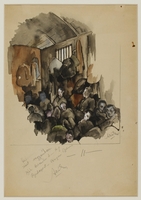
Drawing by Ervin Abadi created while at Bergen Belsen displaced person's camp
Object
Artistic rendering of Camp Bergen-Belsen documenting the liberation period. The artist Erwin Abadi was an Hungarian victim of the Holocaust interned in the concentration camp Bergen-Belsen. He remained hospitalized in Belsen after liberation where he created dozens of works of art.
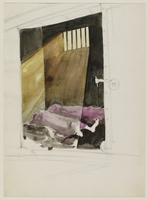
Drawing by Ervin Abadi created while at Bergen Belsen displaced person's camp
Object
Artistic rendering of Camp Bergen-Belsen documenting the liberation period. The artist Erwin Abadi was an Hungarian victim of the Holocaust interned in the concentration camp Bergen-Belsen. He remained hospitalized in Belsen after liberation where he created dozens of works of art.
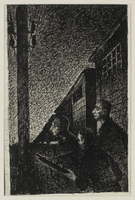
Drawing by Ervin Abadi created while at Bergen Belsen displaced person's camp
Object
Artistic rendering of Camp Bergen-Belsen documenting the liberation period. The artist Erwin Abadi was an Hungarian victim of the Holocaust interned in the concentration camp Bergen-Belsen. He remained hospitalized in Belsen after liberation where he created dozens of works of art.
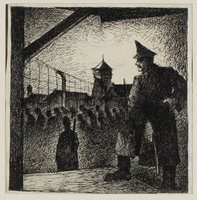
Drawing by Ervin Abadi created while at Bergen Belsen displaced person's camp
Object
Artistic rendering of Camp Bergen-Belsen documenting the liberation period. The artist Erwin Abadi was an Hungarian victim of the Holocaust interned in the concentration camp Bergen-Belsen. He remained hospitalized in Belsen after liberation where he created dozens of works of art.

Drawing by Ervin Abadi created while at Bergen Belsen displaced person's camp
Object
Artistic rendering of Camp Bergen-Belsen documenting the liberation period. The artist Erwin Abadi was an Hungarian victim of the Holocaust interned in the concentration camp Bergen-Belsen. He remained hospitalized in Belsen after liberation where he created dozens of works of art.
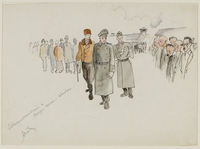
Drawing by Ervin Abadi created while at Bergen Belsen displaced person's camp
Object
Artistic rendering of Camp Bergen-Belsen documenting the liberation period. The artist Erwin Abadi was an Hungarian victim of the Holocaust interned in the concentration camp Bergen-Belsen. He remained hospitalized in Belsen after liberation where he created dozens of works of art.
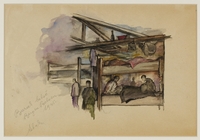
Drawing by Ervin Abadi created while at Bergen Belsen displaced person's camp
Object
Artistic rendering of Camp Bergen-Belsen documenting the liberation period. The artist Erwin Abadi was an Hungarian victim of the Holocaust interned in the concentration camp Bergen-Belsen. He remained hospitalized in Belsen after liberation where he created dozens of works of art.
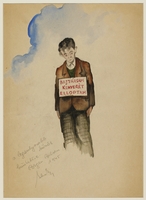
Drawing by Ervin Abadi created while at Bergen Belsen displaced person's camp
Object
Artistic rendering of Camp Bergen-Belsen documenting the liberation period. The artist Erwin Abadi was an Hungarian victim of the Holocaust interned in the concentration camp Bergen-Belsen. He remained hospitalized in Belsen after liberation where he created dozens of works of art.
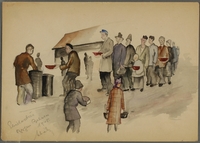
Watercolor painting by Ervin Abadi created while at Bergen Belsen displaced person's camp
Object
Artistic rendering of Camp Bergen-Belsen documenting the liberation period. The artist Erwin Abadi was an Hungarian victim of the Holocaust interned in the concentration camp Bergen-Belsen. He remained hospitalized in Belsen after liberation where he created dozens of works of art.
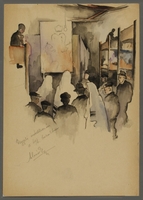
Drawing by Ervin Abadi created while at Bergen Belsen displaced person's camp
Object
Artistic rendering of Camp Bergen-Belsen documenting the liberation period. The artist Erwin Abadi was an Hungarian victim of the Holocaust interned in the concentration camp Bergen-Belsen. He remained hospitalized in Belsen after liberation where he created dozens of works of art.
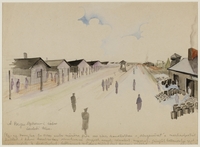
Drawing by Ervin Abadi created while at Bergen Belsen displaced person's camp
Object
Artistic rendering of Camp Bergen-Belsen documenting the liberation period. The artist Erwin Abadi was an Hungarian victim of the Holocaust interned in the concentration camp Bergen-Belsen. He remained hospitalized in Belsen after liberation where he created dozens of works of art.

Watercolor painting by Ervin Abadi created while at Bergen Belsen displaced person's camp
Object
Artistic rendering of Camp Bergen-Belsen documenting the liberation period. The artist Erwin Abadi was an Hungarian victim of the Holocaust interned in the concentration camp Bergen-Belsen. He remained hospitalized in Belsen after liberation where he created dozens of works of art.
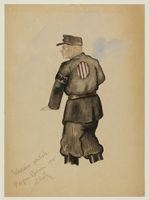
Drawing by Ervin Abadi created while at Bergen Belsen displaced person's camp
Object
Artistic rendering of Camp Bergen-Belsen documenting the liberation period. The artist Erwin Abadi was an Hungarian victim of the Holocaust interned in the concentration camp Bergen-Belsen. He remained hospitalized in Belsen after liberation where he created dozens of works of art.
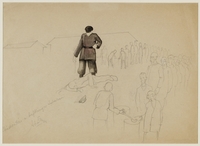
Drawing by Ervin Abadi created while at Bergen Belsen displaced person's camp
Object
Artistic rendering of Camp Bergen-Belsen documenting the liberation period. The artist Erwin Abadi was an Hungarian victim of the Holocaust interned in the concentration camp Bergen-Belsen. He remained hospitalized in Belsen after liberation where he created dozens of works of art.
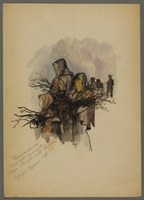
Drawing by Ervin Abadi created while at Bergen Belsen displaced person's camp
Object
Artistic rendering of Camp Bergen-Belsen documenting the liberation period. The artist Erwin Abadi was an Hungarian victim of the Holocaust interned in the concentration camp Bergen-Belsen. He remained hospitalized in Belsen after liberation where he created dozens of works of art.
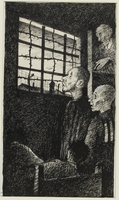
Drawing by Ervin Abadi created while at Bergen Belsen displaced person's camp
Object
Artistic rendering of Camp Bergen-Belsen documenting the liberation period. The artist Erwin Abadi was an Hungarian victim of the Holocaust interned in the concentration camp Bergen-Belsen. He remained hospitalized in Belsen after liberation where he created dozens of works of art.
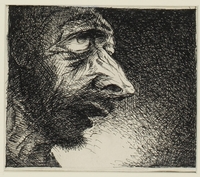
Drawing by Ervin Abadi created while at Bergen Belsen displaced person's camp
Object
Artistic rendering of Camp Bergen-Belsen documenting the liberation period. The artist Erwin Abadi was an Hungarian victim of the Holocaust interned in the concentration camp Bergen-Belsen. He remained hospitalized in Belsen after liberation where he created dozens of works of art.
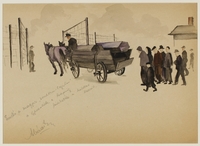
Drawing by Ervin Abadi created while at Bergen Belsen displaced person's camp
Object
Artistic rendering of Camp Bergen-Belsen documenting the liberation period. The artist Erwin Abadi was an Hungarian victim of the Holocaust interned in the concentration camp Bergen-Belsen. He remained hospitalized in Belsen after liberation where he created dozens of works of art.
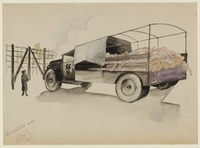
Drawing by Ervin Abadi created while at Bergen Belsen displaced person's camp
Object
Artistic rendering of Camp Bergen-Belsen documenting the liberation period. The artist Erwin Abadi was an Hungarian victim of the Holocaust interned in the concentration camp Bergen-Belsen. He remained hospitalized in Belsen after liberation where he created dozens of works of art.
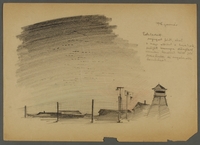
Drawing by Ervin Abadi created while at Bergen Belsen displaced person's camp
Object
Artistic rendering of Camp Bergen-Belsen documenting the liberation period. The artist Erwin Abadi was an Hungarian victim of the Holocaust interned in the concentration camp Bergen-Belsen. He remained hospitalized in Belsen after liberation where he created dozens of works of art.
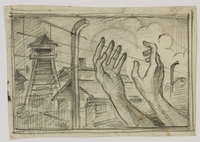
Drawing by Ervin Abadi created while at Bergen Belsen displaced person's camp
Object
Artistic rendering of Camp Bergen-Belsen documenting the liberation period. The artist Erwin Abadi was an Hungarian victim of the Holocaust interned in the concentration camp Bergen-Belsen. He remained hospitalized in Belsen after liberation where he created dozens of works of art.
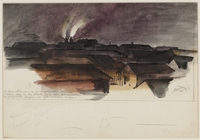
Drawing by Ervin Abadi created while at Bergen Belsen displaced person's camp
Object
Artistic rendering of Camp Bergen-Belsen documenting the liberation period. The artist Erwin Abadi was an Hungarian victim of the Holocaust interned in the concentration camp Bergen-Belsen. He remained hospitalized in Belsen after liberation where he created dozens of works of art.
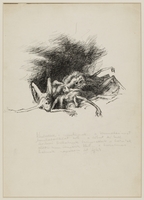
Drawing by Ervin Abadi created while at Bergen Belsen displaced person's camp
Object
Artistic rendering of Camp Bergen-Belsen documenting the liberation period. The artist Erwin Abadi was an Hungarian victim of the Holocaust interned in the concentration camp Bergen-Belsen. He remained hospitalized in Belsen after liberation where he created dozens of works of art.
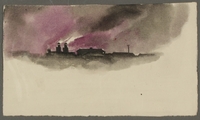
Watercolor painting by Ervin Abadi created while at Bergen Belsen displaced person's camp
Object
Artistic rendering of Camp Bergen-Belsen documenting the liberation period. The artist Erwin Abadi was an Hungarian victim of the Holocaust interned in the concentration camp Bergen-Belsen. He remained hospitalized in Belsen after liberation where he created dozens of works of art.
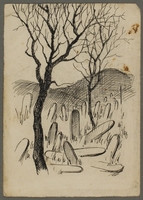
Drawing by Ervin Abadi created while at Bergen Belsen displaced person's camp
Object
Artistic rendering of Camp Bergen-Belsen documenting the liberation period. The artist Erwin Abadi was an Hungarian victim of the Holocaust interned in the concentration camp Bergen-Belsen. He remained hospitalized in Belsen after liberation where he created dozens of works of art.
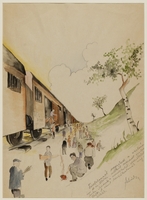
Drawing by Ervin Abadi created while at Bergen Belsen displaced person's camp
Object
Artistic rendering of Camp Bergen-Belsen documenting the liberation period. The artist Erwin Abadi was an Hungarian victim of the Holocaust interned in the concentration camp Bergen-Belsen. He remained hospitalized in Belsen after liberation where he created dozens of works of art.
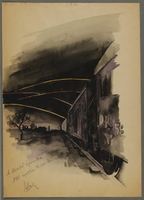
Drawing by Ervin Abadi created while at Bergen Belsen displaced person's camp
Object
Artistic rendering of Camp Bergen-Belsen documenting the liberation period. The artist Erwin Abadi was an Hungarian victim of the Holocaust interned in the concentration camp Bergen-Belsen. He remained hospitalized in Belsen after liberation where he created dozens of works of art.
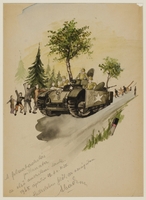
Watercolor painting by Ervin Abadi created while at Bergen Belsen displaced person's camp
Object
Artistic rendering of Camp Bergen-Belsen documenting the liberation period. The artist Erwin Abadi was an Hungarian victim of the Holocaust interned in the concentration camp Bergen-Belsen. He remained hospitalized in Belsen after liberation where he created dozens of works of art.
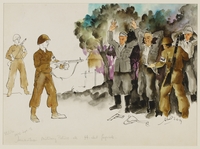
Drawing by Ervin Abadi created while at Bergen Belsen displaced person's camp
Object
Artistic rendering of Camp Bergen-Belsen documenting the liberation period. The artist Erwin Abadi was an Hungarian victim of the Holocaust interned in the concentration camp Bergen-Belsen. He remained hospitalized in Belsen after liberation where he created dozens of works of art.
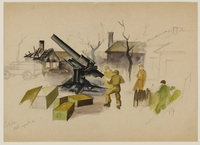
Drawing by Ervin Abadi created while at Bergen Belsen displaced person's camp
Object
Artistic rendering of Camp Bergen-Belsen documenting the liberation period. The artist Erwin Abadi was an Hungarian victim of the Holocaust interned in the concentration camp Bergen-Belsen. He remained hospitalized in Belsen after liberation where he created dozens of works of art.
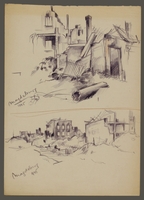
Drawing by Ervin Abadi created while at Bergen Belsen displaced person's camp
Object
Artistic rendering of Camp Bergen-Belsen documenting the liberation period. The artist Erwin Abadi was an Hungarian victim of the Holocaust interned in the concentration camp Bergen-Belsen. He remained hospitalized in Belsen after liberation where he created dozens of works of art.
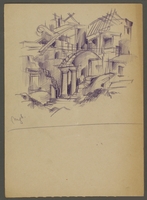
Drawing by Ervin Abadi created while at Bergen Belsen displaced person's camp
Object
Artistic rendering of Camp Bergen-Belsen documenting the liberation period. The artist Erwin Abadi was an Hungarian victim of the Holocaust interned in the concentration camp Bergen-Belsen. He remained hospitalized in Belsen after liberation where he created dozens of works of art.

Drawing by Ervin Abadi created while at Bergen Belsen displaced person's camp
Object
Artistic rendering of Camp Bergen-Belsen documenting the liberation period. The artist Erwin Abadi was an Hungarian victim of the Holocaust interned in the concentration camp Bergen-Belsen. He remained hospitalized in Belsen after liberation where he created dozens of works of art.
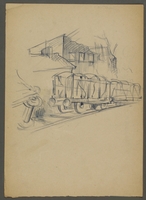
Drawing by Ervin Abadi created while at Bergen Belsen displaced person's camp
Object
Artistic rendering of Camp Bergen-Belsen documenting the liberation period. The artist Erwin Abadi was an Hungarian victim of the Holocaust interned in the concentration camp Bergen-Belsen. He remained hospitalized in Belsen after liberation where he created dozens of works of art.

Drawing by Ervin Abadi created while at Bergen Belsen displaced person's camp
Object
Artistic rendering of Camp Bergen-Belsen documenting the liberation period. The artist Erwin Abadi was an Hungarian victim of the Holocaust interned in the concentration camp Bergen-Belsen. He remained hospitalized in Belsen after liberation where he created dozens of works of art.
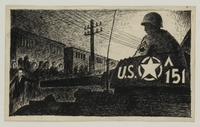
Drawing by Ervin Abadi created while at Bergen Belsen displaced person's camp
Object
Artistic rendering of Camp Bergen-Belsen documenting the liberation period. The artist Erwin Abadi was an Hungarian victim of the Holocaust interned in the concentration camp Bergen-Belsen. He remained hospitalized in Belsen after liberation where he created dozens of works of art.
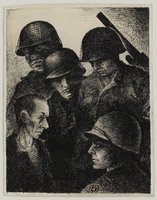
Drawing by Ervin Abadi created while at Bergen Belsen displaced person's camp
Object
Artistic rendering of Camp Bergen-Belsen documenting the liberation period. The artist Erwin Abadi was an Hungarian victim of the Holocaust interned in the concentration camp Bergen-Belsen. He remained hospitalized in Belsen after liberation where he created dozens of works of art.
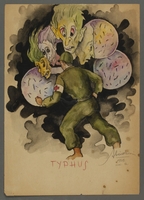
Drawing by Ervin Abadi created while at Bergen Belsen displaced person's camp
Object
Artistic rendering of Camp Bergen-Belsen documenting the liberation period. The artist Erwin Abadi was an Hungarian victim of the Holocaust interned in the concentration camp Bergen-Belsen. He remained hospitalized in Belsen after liberation where he created dozens of works of art.
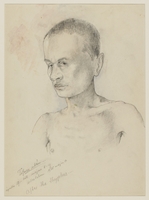
Drawing by Ervin Abadi created while at Bergen Belsen displaced person's camp
Object
Artistic rendering of Camp Bergen-Belsen documenting the liberation period. The artist Erwin Abadi was an Hungarian victim of the Holocaust interned in the concentration camp Bergen-Belsen. He remained hospitalized in Belsen after liberation where he created dozens of works of art.
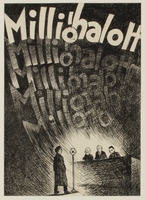
Drawing by Ervin Abadi created while at Bergen Belsen displaced person's camp
Object
Artistic rendering of Camp Bergen-Belsen documenting the liberation period. The artist Erwin Abadi was an Hungarian victim of the Holocaust interned in the concentration camp Bergen-Belsen. He remained hospitalized in Belsen after liberation where he created dozens of works of art.
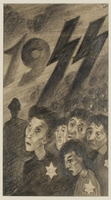
Drawing by Ervin Abadi created while at Bergen Belsen displaced person's camp
Object
Artistic rendering of Camp Bergen-Belsen documenting the liberation period. The artist Erwin Abadi was an Hungarian victim of the Holocaust interned in the concentration camp Bergen-Belsen. He remained hospitalized in Belsen after liberation where he created dozens of works of art.
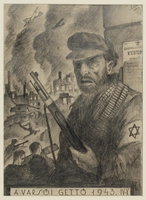
Drawing by Ervin Abadi created while at Bergen Belsen displaced person's camp
Object
Artistic rendering of Camp Bergen-Belsen documenting the liberation period. The artist Erwin Abadi was an Hungarian victim of the Holocaust interned in the concentration camp Bergen-Belsen. He remained hospitalized in Belsen after liberation where he created dozens of works of art.
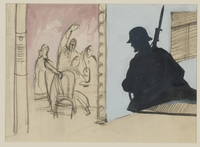
Painting by Ervin Abadi created while at Bergen Belsen displaced person's camp
Object
Artistic rendering of Camp Bergen-Belsen documenting the liberation period. The artist Erwin Abadi was an Hungarian victim of the Holocaust interned in the concentration camp Bergen-Belsen. He remained hospitalized in Belsen after liberation where he created dozens of works of art.

Drawing by Ervin Abadi created while at Bergen Belsen displaced person's camp
Object
Artistic rendering of Camp Bergen-Belsen documenting the liberation period. The artist Erwin Abadi was an Hungarian victim of the Holocaust interned in the concentration camp Bergen-Belsen. He remained hospitalized in Belsen after liberation where he created dozens of works of art.
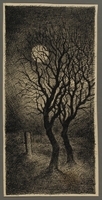
Drawing by Ervin Abadi created while at Bergen Belsen displaced person's camp
Object
Artistic rendering of Camp Bergen-Belsen documenting the liberation period. The artist Erwin Abadi was an Hungarian victim of the Holocaust interned in the concentration camp Bergen-Belsen. He remained hospitalized in Belsen after liberation where he created dozens of works of art.
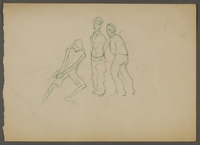
Drawing by Ervin Abadi created while at Bergen Belsen displaced person's camp
Object
Artistic rendering of Camp Bergen-Belsen documenting the liberation period. The artist Erwin Abadi was an Hungarian victim of the Holocaust interned in the concentration camp Bergen-Belsen. He remained hospitalized in Belsen after liberation where he created dozens of works of art.
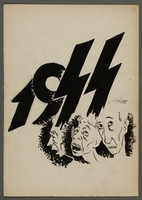
Drawing by Ervin Abadi created while at Bergen Belsen displaced person's camp
Object
Artistic rendering of Camp Bergen-Belsen documenting the liberation period. The artist Erwin Abadi was an Hungarian victim of the Holocaust interned in the concentration camp Bergen-Belsen. He remained hospitalized in Belsen after liberation where he created dozens of works of art.
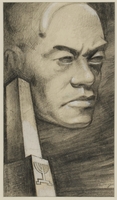
Drawing by Ervin Abadi created while at Bergen Belsen displaced person's camp
Object
Artistic rendering of Camp Bergen-Belsen documenting the liberation period. The artist Erwin Abadi was an Hungarian victim of the Holocaust interned in the concentration camp Bergen-Belsen. He remained hospitalized in Belsen after liberation where he created dozens of works of art.
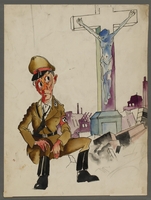
Drawing by Ervin Abadi created while at Bergen Belsen displaced person's camp
Object
Artistic rendering of Camp Bergen-Belsen documenting the liberation period. The artist Erwin Abadi was an Hungarian victim of the Holocaust interned in the concentration camp Bergen-Belsen. He remained hospitalized in Belsen after liberation where he created dozens of works of art.
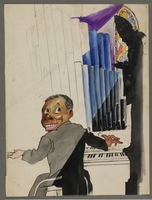
Drawing by Ervin Abadi created while at Bergen Belsen displaced person's camp
Object
Artistic rendering of Camp Bergen-Belsen documenting the liberation period. The artist Erwin Abadi was an Hungarian victim of the Holocaust interned in the concentration camp Bergen-Belsen. He remained hospitalized in Belsen after liberation where he created dozens of works of art.

Drawing by Ervin Abadi created while at Bergen Belsen displaced person's camp
Object
Artistic rendering of Camp Bergen-Belsen documenting the liberation period. The artist Erwin Abadi was an Hungarian victim of the Holocaust interned in the concentration camp Bergen-Belsen. He remained hospitalized in Belsen after liberation where he created dozens of works of art.
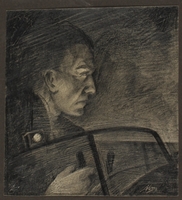
Drawing by Ervin Abadi created while at Bergen Belsen displaced person's camp
Object
Artistic rendering of Camp Bergen-Belsen documenting the liberation period. The artist Erwin Abadi was an Hungarian victim of the Holocaust interned in the concentration camp Bergen-Belsen. He remained hospitalized in Belsen after liberation where he created dozens of works of art.
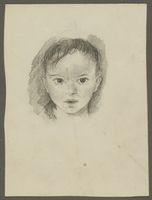
Drawing by Ervin Abadi created while at Bergen Belsen displaced person's camp
Object
Artistic rendering of Camp Bergen-Belsen documenting the liberation period. The artist Erwin Abadi was an Hungarian victim of the Holocaust interned in the concentration camp Bergen-Belsen. He remained hospitalized in Belsen after liberation where he created dozens of works of art.
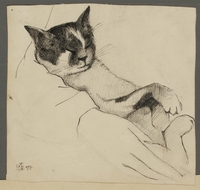
Drawing by Ervin Abadi created while at Bergen Belsen displaced person's camp
Object
Artistic rendering of Camp Bergen-Belsen documenting the liberation period. The artist Erwin Abadi was an Hungarian victim of the Holocaust interned in the concentration camp Bergen-Belsen. He remained hospitalized in Belsen after liberation where he created dozens of works of art.
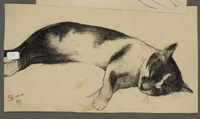
Drawing by Ervin Abadi created while at Bergen Belsen displaced person's camp
Object
Artistic rendering of Camp Bergen-Belsen documenting the liberation period. The artist Erwin Abadi was an Hungarian victim of the Holocaust interned in the concentration camp Bergen-Belsen. He remained hospitalized in Belsen after liberation where he created dozens of works of art.
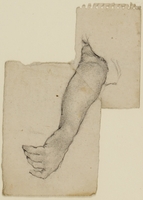
Drawing by Ervin Abadi created while at Bergen Belsen displaced person's camp
Object
Artistic rendering of Camp Bergen-Belsen documenting the liberation period. The artist Erwin Abadi was an Hungarian victim of the Holocaust interned in the concentration camp Bergen-Belsen. He remained hospitalized in Belsen after liberation where he created dozens of works of art.
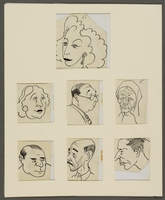
Drawing by Ervin Abadi created while at Bergen Belsen displaced person's camp
Object
Artistic rendering of Camp Bergen-Belsen documenting the liberation period. The artist Erwin Abadi was an Hungarian victim of the Holocaust interned in the concentration camp Bergen-Belsen. He remained hospitalized in Belsen after liberation where he created dozens of works of art.
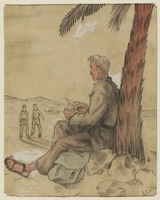
Drawing by Ervin Abadi created while at Bergen Belsen displaced person's camp
Object
Artistic rendering of Camp Bergen-Belsen documenting the liberation period. The artist Erwin Abadi was an Hungarian victim of the Holocaust interned in the concentration camp Bergen-Belsen. He remained hospitalized in Belsen after liberation where he created dozens of works of art.
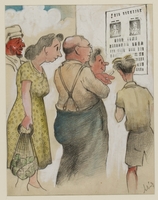
Drawing by Ervin Abadi created while at Bergen Belsen displaced person's camp
Object
Artistic rendering of Camp Bergen-Belsen documenting the liberation period. The artist Erwin Abadi was an Hungarian victim of the Holocaust interned in the concentration camp Bergen-Belsen. He remained hospitalized in Belsen after liberation where he created dozens of works of art.



